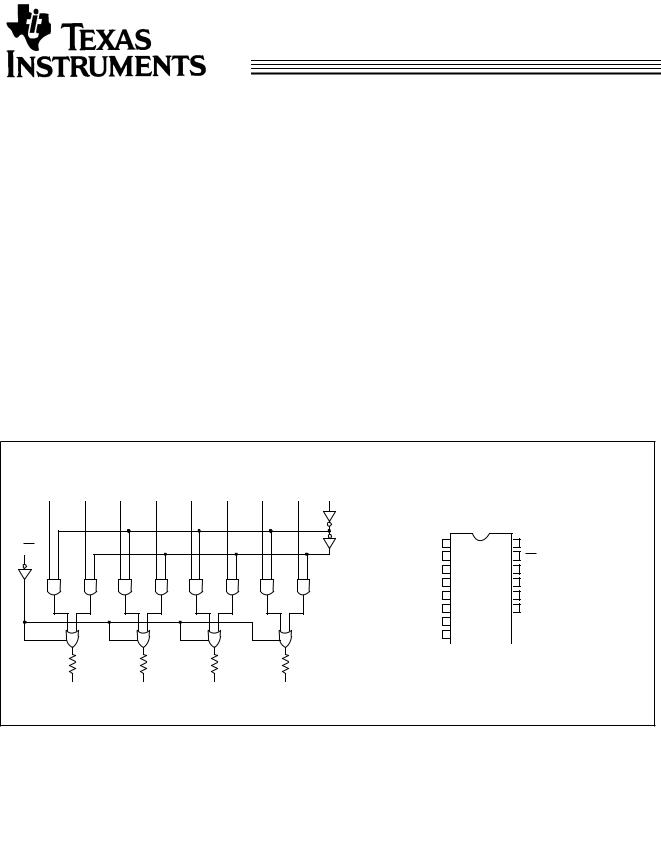Texas Instruments CY74FCT2257CTSOCT, CY74FCT2257CTSOC, CY74FCT2257CTQCT, CY74FCT2257CTQC, CY74FCT2257ATQCT Datasheet
...
Data sheet acquired from Cypress Semiconductor Corporation.
Data sheet modified to remove devices not offered.
CY74FCT2257T
SCCS038 - September 1994 - Revised March 2000
Features
•Function and pinout compatible with FCT and F logic
•25Ω output series resistors to reduce transmission line reflection noise
•FCT-C speed at 4.3 ns max.,
FCT-A speed at 5.0 ns max.
•TTL output level versions of equivalent FCT functions
•Edge-rate control circuitry for significantly improved noise characteristics
•Power-off disable feature
•Fully compatible with TTL input and output logic levels
•ESD > 2000V
•Sink current 12 mA Source current15 mA
•Extended commercial temp. range of –40˚C to +85˚C
•Three-state outputs
Quad 2-Input Multiplexer
Functional Description
The FCT2257T has four identical two-input multiplexers that select four bits of data from two sources under the control of a common data Select input (S). The I0 inputs are selected when the Select input is LOW and the I1 inputs are selected when the Select input is HIGH. Data appears at the output in true non-inverted form for the FCT2257T. On-chip termination resistors have been added to the outputs to reduce system noise caused by reflections. The FCT2257T can be used to replace the FCT257T to reduce noise in an existing design.
The FCT2257T is a logic implementation of a four-pole, two-position switch where the position of the switch is determined by the logic levels supplied to the select input. Outputs are forced to a high-impedance “OFF” state when the Output Enable input (OE) is HIGH.
All but one device must be in the high-impedance state to avoid currents exceeding the maximum ratings if outputs are tied together. Design of the output enable signals must ensure that there is no overlap when outputs of three-state devices are tied together.
The outputs are designed with a power-off disable feature to allow for live insertion of boards.
Logic Block Diagram |
Pin Configurations |
I0a |
I1a |
I0b |
I1b |
I0c |
I1c |
I0d |
I1d |
S |
|
|
|
|
|
|
|
|
|
|
|
|
SOIC/QSOP |
|
|
|
|
|
|
|
|
|
|
|
|
Top View |
|
OE |
|
|
|
|
|
|
|
S |
1 |
16 |
VCC |
|
|
|
|
|
|
|
I0a |
|
|
|
|
|
|
|
|
|
|
|
|
2 |
15 |
OE |
|
|
|
|
|
|
|
|
|
I1a |
3 |
14 |
I0c |
|
|
|
|
|
|
|
|
Ya |
4 |
13 |
I1c |
|
|
|
|
|
|
|
|
I0b |
5 |
12 |
Yc |
|
|
|
|
|
|
|
|
I1b |
6 |
11 |
I0d |
|
|
|
|
|
|
|
|
|
|
||
Yb |
7 |
10 |
|
|
I1d |
GND |
|
Yd |
|||
8 |
9 |
|
|
||
|
|
|
|
|
|
|
|
FCT2257T–3 |
|||
Ya |
Yb |
Yc |
Yd |
FCT2257T–1
Pin Description
|
Name |
Description |
|
|
|
|
|
|
I |
Data Inputs |
|
|
|
|
|
|
S |
Common Select Input |
|
|
|
|
|
|
|
|
Enable Inputs (Active LOW) |
|
OE |
||
|
|
|
|
|
Y |
Data Outputs |
|
|
|
|
|
Function Table[1]
|
|
|
|
Inputs |
|
Output |
|
|
|
|
|
|
|
|
|
|
|
|
S |
|
I0 |
I1 |
Y |
OE |
|||||||
|
H |
X |
|
X |
X |
Z |
|
|
L |
H |
|
X |
L |
L |
|
|
L |
H |
|
X |
H |
H |
|
|
L |
L |
|
L |
X |
L |
|
|
L |
L |
|
H |
X |
H |
|
|
|
|
|
|
|
|
|
Note:
1.H = HIGH Voltage Level, L = LOW Voltage Level, X = Don’t Care, Z = High impedance (OFF) state.
Copyright © 2000, Texas Instruments Incorporated

CY74FCT2257T
Maximum Ratings[2, 3]
(Above which the useful life may be impaired. For user guidelines, not tested.)
Storage Temperature ................................. |
–65°C to +150°C |
Ambient Temperature with |
–65°C to +135°C |
Power Applied ............................................. |
|
Supply Voltage to Ground Potential ............... |
–0.5V to +7.0V |
DC Input Voltage............................................ |
–0.5V to +7.0V |
DC Output Voltage ......................................... |
–0.5V to +7.0V |
Electrical Characteristics Over the Operating Range
DC Output Current (Maximum Sink Current/Pin) ...... |
120 mA |
Power Dissipation .......................................................... |
0.5W |
Static Discharge Voltage............................................ |
>2001V |
(per MIL-STD-883, Method 3015) |
|
Operating Range
|
Ambient |
|
Range |
Temperature |
VCC |
Commercial |
–40°C to +85°C |
5V ± 5% |
|
|
|
Parameter |
Description |
|
Test Conditions |
Min. |
Typ.[5] |
Max. |
Unit |
|
VOH |
Output HIGH Voltage |
VCC=Min., IOH=–15 mA |
2.4 |
3.3 |
|
V |
||
VOL |
Output LOW Voltage |
VCC=Min., IOL=12 mA |
|
0.3 |
0.55 |
V |
||
ROUT |
Output Resistance |
VCC=Min., IOL=12 mA |
20 |
25 |
40 |
Ω |
||
VIH |
Input HIGH Voltage |
|
|
2.0 |
|
|
V |
|
VIL |
Input LOW Voltage |
|
|
|
|
0.8 |
V |
|
VH |
Hysteresis[6] |
All inputs |
|
0.2 |
|
V |
||
VIK |
Input Clamp Diode Voltage |
VCC=Min., IIN=–18 mA |
|
–0.7 |
–1.2 |
V |
||
IIH |
Input HIGH Current |
VCC=Max., VIN=2.7V |
|
|
±1 |
µA |
||
IIL |
Input LOW Current |
VCC=Max., VIN=0.5V |
|
|
±1 |
µA |
||
IOZH |
Off State HIGH-Level Output |
VCC=Max., VOUT=2.7V |
|
|
10 |
µA |
||
|
|
Current |
|
|
|
|
|
|
|
|
|
|
|
|
|
||
IOZL |
Off State LOW-Level |
VCC=Max., VOUT=0.5V |
|
|
–10 |
µA |
||
|
|
Output Current |
|
|
|
|
|
|
|
|
|
|
|
|
|
|
|
I |
OS |
Output Short Circuit Current[7] |
V |
=Max., V =0.0V |
–60 |
–120 |
–225 |
mA |
|
|
CC |
OUT |
|
|
|
|
|
IOFF |
Power-Off Disable |
VCC=0V, VOUT=4.5V |
|
|
±1 |
µA |
||
Capacitance[6]
Parameter |
Description |
Test Conditions |
Typ.[5] |
Max. |
Unit |
CIN |
Input Capacitance |
|
5 |
10 |
pF |
COUT |
Output Capacitance |
|
9 |
12 |
pF |
Notes: |
|
|
|
|
|
2.Unless otherwise noted, these limits are over the operating free-air temperature range.
3.Unused inputs must always be connected to an appropriate logic voltage level, preferably either VCC or ground.
4.TA is the “instant on” case temperature.
5.Typical values are at VCC=5.0V, TA=+25˚C ambient.
6.This parameter is specified but not tested.
7.Not more than one output should be shorted at a time. Duration of short should not exceed one second. The use of high-speed test apparatus and/or sample and hold techniques are preferable in order to minimize internal chip heating and more accurately reflect operational values. Otherwise prolonged shorting of a high output may raise the chip temperature well above normal and thereby cause invalid readings in other parametric tests. In any sequence of parameter tests, IOS tests should be performed last.
2
